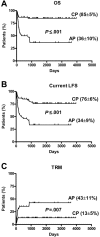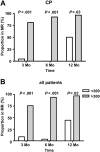Factors associated with early molecular remission after T cell-depleted allogeneic stem cell transplantation for chronic myelogenous leukemia
- PMID: 16131570
- PMCID: PMC1895415
- DOI: 10.1182/blood-2005-05-1897
Factors associated with early molecular remission after T cell-depleted allogeneic stem cell transplantation for chronic myelogenous leukemia
Abstract
Eighty patients with chronic myeloid leukemia (CML) underwent T cell-depleted stem cell transplantation from an HLA-identical sibling, with add-back of donor T cells on days 30 to 45 and days 60 to 100 in patients in whom grade 2 or greater acute graft-versus-host disease (GVHD) developed. The outcomes for 54 patients with chronic-phase (CP) and 26 with advanced-phase (AP) disease were as follows: overall survival, 85% +/- 5% versus 36% +/- 10%; transplantation-related mortality (TRM), 13% +/- 5% versus 43% +/- 11%; and current leukemia-free survival, 76% +/- 6% versus 34% +/- 9%. The day-30 lymphocyte count (LC30) was strongly associated with outcome. For patients in CP with counts greater than the median of 0.30 x 10(9)/L, survival was 100% versus 70% +/- 9% (P = .003); current LFS 100% versus 56% +/- 9% (P = .002); and TRM 0% versus 26% +/- 8% (P = .006). Higher-than-median LC30 correlated significantly with molecular remission (MR) at 3, 6, and 12 months and with higher CD34 doses. Lymphocyte subset analysis performed in 20 patients available for phenotyping showed that LC30 was highly correlated with absolute CD56+CD3- natural killer cell numbers (NK30), which also predicted for survival and MR. CD34 cell dose, LC30, and NK30, but not day-30 CD3+ cell count, were highly correlated and were significant predictors of transplantation outcome. These results suggest that transplanted CD34 cell doses greater than 5 x 10(6)/kg may improve outcomes by increasing the early recovery of NK cells.
Figures



Similar articles
-
Lymphocyte recovery is a major determinant of outcome after matched unrelated myeloablative transplantation for myelogenous malignancies.Biol Blood Marrow Transplant. 2009 Sep;15(9):1108-15. doi: 10.1016/j.bbmt.2009.05.015. Biol Blood Marrow Transplant. 2009. PMID: 19660724 Free PMC article.
-
Rapid engraftment after allogeneic transplantation of density-enriched peripheral blood CD34+ cells in patients with advanced hematologic malignancies.Cancer. 2001 Jun 15;91(12):2205-13. Cancer. 2001. PMID: 11413507
-
Outcome of transplantation of highly purified peripheral blood CD34+ cells with T-cell add-back compared with unmanipulated bone marrow or peripheral blood stem cells from HLA-identical sibling donors in patients with first chronic phase chronic myeloid leukemia.Blood. 2003 Jan 15;101(2):446-53. doi: 10.1182/blood-2002-05-1615. Epub 2002 Sep 12. Blood. 2003. PMID: 12393406
-
Absolute lymphocyte count on day 30 is a surrogate for robust hematopoietic recovery and strongly predicts outcome after T cell-depleted allogeneic stem cell transplantation.Biol Blood Marrow Transplant. 2007 Oct;13(10):1216-23. doi: 10.1016/j.bbmt.2007.07.005. Epub 2007 Aug 24. Biol Blood Marrow Transplant. 2007. PMID: 17889359 Free PMC article.
-
Treatment of CML with unrelated donor marrow transplant.Leuk Lymphoma. 1993;11 Suppl 1:209-11. doi: 10.3109/10428199309047888. Leuk Lymphoma. 1993. PMID: 8251898 Review.
Cited by
-
A novel immature natural killer cell subpopulation predicts relapse after cord blood transplantation.Blood Adv. 2019 Dec 10;3(23):4117-4130. doi: 10.1182/bloodadvances.2019000835. Blood Adv. 2019. PMID: 31821460 Free PMC article.
-
Leukemia burden delays lymphocyte and platelet recovery after allo-SCT for AML.Bone Marrow Transplant. 2009 May;43(9):685-92. doi: 10.1038/bmt.2008.376. Epub 2008 Nov 17. Bone Marrow Transplant. 2009. PMID: 19011667 Free PMC article. Clinical Trial.
-
What is the role for donor natural killer cells after nonmyeloablative conditioning?Biol Blood Marrow Transplant. 2009 May;15(5):580-8. doi: 10.1016/j.bbmt.2009.01.018. Biol Blood Marrow Transplant. 2009. PMID: 19361750 Free PMC article.
-
Donor KIR Genes 2DL5A, 2DS1 and 3DS1 are associated with a reduced rate of leukemia relapse after HLA-identical sibling stem cell transplantation for acute myeloid leukemia but not other hematologic malignancies.Biol Blood Marrow Transplant. 2010 Sep;16(9):1257-64. doi: 10.1016/j.bbmt.2010.03.004. Epub 2010 Mar 17. Biol Blood Marrow Transplant. 2010. PMID: 20302958 Free PMC article.
-
Interleukin-21 promotes thymopoiesis recovery following hematopoietic stem cell transplantation.J Hematol Oncol. 2017 Jun 14;10(1):120. doi: 10.1186/s13045-017-0490-3. J Hematol Oncol. 2017. PMID: 28615039 Free PMC article.
References
-
- Elmaagacli AH, Peceny R, Steckel N, et al. Outcome of transplantation of highly purified peripheral blood CD34+ cells with T-cell add-back compared with unmanipulated bone marrow or peripheral blood stem cells from HLA-identical sibling donors in patients with first chronic phase chronic myeloid leukemia. Blood. 2003;101: 446-453. - PubMed
-
- van Rhee F, Lin F, Cullis JO, et al. Relapse of chronic myeloid leukemia after allogeneic bone marrow transplant: the case for giving donor leukocyte transfusions before the onset of hematologic relapse. Blood. 1994;83: 3377-3383. - PubMed
-
- Radich JP, Gehly G, Gooley T, et al. Polymerase chain reaction detection of the BCR-ABL fusion transcript after allogeneic marrow transplantation for chronic myeloid leukemia: results and implications in 346 patients. Blood. 1995;85: 2632-2638. - PubMed
-
- Radich JP, Gooley T, Bryant E, et al. The significance of bcr-abl molecular detection in chronic myeloid leukemia patients “late,” 18 months or more after transplantation. Blood. 2001;98: 1701-1707. - PubMed
-
- Branford S, Hughes TP, Rudzki Z. Monitoring chronic myeloid leukaemia therapy by real-time quantitative PCR in blood is a reliable alternative to bone marrow cytogenetics. Br J Haematol. 1999;107: 587-599. - PubMed
MeSH terms
LinkOut - more resources
Full Text Sources
Medical
Research Materials
Miscellaneous

